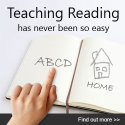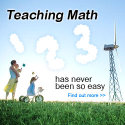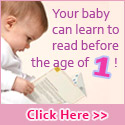Who is Dr Richard Gentry?
A former University professor and elementary school teacher, Dr. Gentry brings to BrillKids over thirty years of experience in the field of early education. He is also the author of many books including Raising Confident Readers: How to Teach Your Child to Read—From Baby to Age 7
How did you first come across the concept of baby and toddler reading, and what were your first thoughts about it?
I’ve studied beginning reading for over thirty years and have written books about how very young children learn to read in school. Although I knew many children
 learned to read as babies and toddlers before entering school, there is little research on 2- and 3-year-old readers and I had not worked with them, so like most reading professors and researchers, baby/toddler reading was an academic blind spot. After being invited to write a book for parents about raising readers, my first thoughts were “Get to work!” I had waited too long to investigate this important topic. It took me three years to write the book!
learned to read as babies and toddlers before entering school, there is little research on 2- and 3-year-old readers and I had not worked with them, so like most reading professors and researchers, baby/toddler reading was an academic blind spot. After being invited to write a book for parents about raising readers, my first thoughts were “Get to work!” I had waited too long to investigate this important topic. It took me three years to write the book!Was there anything that surprised you about the subject, or which you didn’t realize before?
Almost everything I learned surprised me—there were new discoveries about beginning reading with great potential for the reading world. The work I did with parents who were successful teaching their babies and toddlers to read opened new doors to my thinking. I learned that babies learn to read differently and more easily than children who learn to read in school from formal instruction and that the most important aspect of early reading was interaction with loving parents and bonding. I’m convinced that baby/toddler reading has long-term positive effects on children such as better facility with language, building intelligence, and boosting academic success in school.
Why do you think some experts are slow to accept the notion that babies can read?
Some experts don’t understand the importance of early “word reading.” Baby/toddler readers likely go through a different set of steps for organizing the reading brain circuitry than six-year-old nonreaders who learn to read from formal instruction in school. Some experts don’t recognize that babies pick up reading easily from developmentally appropriate interactions with parents and they have special language capacities from birth to age three, just as they do with learning multiple languages, enabling them to do remarkable things with learning to read during this special window of opportunity for brain development. Most of the experts who are skeptical think real reading begins with phonics and they don’t recognize that given the right exposure, toddlers can intuit the rules of phonics over time just like they intuit the rules of grammar which are necessary to speak in sentences. I predict that new discoveries from brain scanning will soon show development of the beginnings of brain circuitry for reading in babies and toddlers. Magnetic electroencepholography has potential to show changes in brain architecture with babies reading words as early as eight months of age and perhaps potential to track how the toddler’s reading brain circuitry grows over time. My hypothesis is that the studies will show development as baby/toddler readers move from reading words to couplets to sentences along with other language related developments.

We know that early reading also includes a lot of early memory reading by children who love reading their favorite books over and over with their parents. But surprisingly, teaching babies and toddlers to read need only take little time—five or ten minutes a day along with routine story reading and book sharing. It’s really about brief lessons that are more like word games to the child, lessons that are fun to play with mom, dad or a care giver along with enjoying books together. All children should have these experiences as babies and toddlers. Experts who aren’t in favor of baby/toddler reading don’t get the concept. They usually think it’s forced, formal, or beyond the babies capacity to read. Of course, it isn’t.
What do you think are the keys to success in teaching babies and toddlers to read?
From an instructional standpoint the keys to success are found in the acronym READ: Repetition—Enthusiasm—Attention—Drawing. (Early pencil and paper activity often leads the child to try writing and to think about how the system works.) But the real keys to success are simple: parent interaction and bonding, enjoying books and word games, never using force. Reading? If you put it out there and let babies and toddlers have fun with it they soak it up.
Source: http://blog.brillkids.com/
































0 comments:
Post a Comment